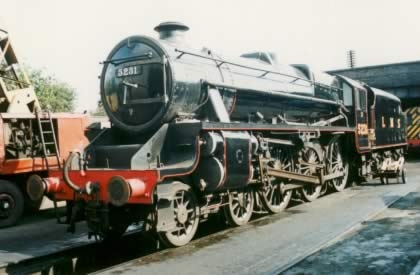|
Author
|
Topic: Black Five
|
Steve Klare
Film Guy

Posts: 7016
From: Long Island, NY, USA
Registered: Jun 2003
|
 posted April 15, 2008 09:27 PM
posted April 15, 2008 09:27 PM




Black Five (1x400í, 1968, British Film Institute, available from Derann Film Services)
Black Five is not the typical railroad film. Many of the best of these are a Railfanís way of preserving the images of passing trains so they can see them again, and sometimes they wind up being shadows of long gone trains and rail lines surviving well beyond the times when the original scenes have vanished. Black Five is different: just as much as it does show the trains it also allows the men who operated them to talk about their times, their passing and what it means to them. It is much more a documentary about changing times than simply scenes trackside.
The film was made in the late 1960s, when British Rail was phasing out the last Class 5MT (Black Five) 4-6-0 steam locomotives and replacing them with diesels, thereby completing the elimination of mainline steam throughout the system. Where it breaks the mold of standard railroad films is by presenting the locomotives operating and being maintained without commentary or subtitles, but at the same time firemen and driversí discussions of their experiences and impressions are dubbed over the location sound track. The conversation tends to loosely follow the visuals (or vice versa), but is not as if the speakers were watching the footage and directly commenting on it.
Itís not so much about where they are or where they are headed, but what they could do and what happened while they were doing it.
Watching this film was kind of a miniature research project for me at first. The railway men are often speaking in a fairly echoic room with a tape recorder, and speaking in British railroad slang. Early on, I thought ďWhat did he say?Ē quite a bit, but gradually worked it all out, including stories of an inexperienced driver steaming down the tracks trainless after forgetting to couple up and another forgetting to spot his engine under the coaling tower and a couple of tons of coal pouring onto the track instead of into the tender. There is also a discussion about how the quality of coal varies from region to region: therefore the art of firing an engine on a long distance run changes every time they stop to take on coal (..something Iíd never thought about before). I guess watching this one just once could be a waste of time, since I find something new every time I project it!
There are some nice action sequences, including some pretty violent shunting, some nice footage shot from the footplate of a goods train crossing pasturelands and some passing passenger trains as well. Inside the shop there is enough pounding, milling and grinding going on to satisfy any machine-tool junkie! The camera work suggests somebody that knows and loves steam locomotives: the shots of things like driving rods and valve gear are up close and personal.
My greatest gripe with this film has to be the color. My print runs very much on the blue side. The black engines are bluish black, the green grass is bluish green. Even the clouds of steam are bluish white Every so often some red pops up and it really hits your eye. If I had the choice, Iíd actually prefer this one in black and white.
The audio is very good where it comes to location sound, yet itís a shame the original filmmakers didnít do a better job recording the voices of the railway men.
Black Five does a subtle job of showing the ending of mainline steam locomotion in Great Britain. At the beginning of the film there is a great deal of steam activity, and gradually more and more diesels are shown. Towards the end, the scenes turn to silent yards and roundhouses, and the voices comment on how children growing up will never experience the presence of a steam locomotive as their own generation did. At the end, without commentary at all, a diesel hauls a line of dead steam engines past the camera, obviously headed for the torch.
This film is available new from Derann.
Note: The BFI is releasing this film on DVD this August in commemoration of 40 years since the passing of Steam.
-Isnít it nice to know We of the Film Fraternity have had it all along!
--------------------
All I ask is a wide screen and a projector to light her by...
| IP: Logged
|
|
Osi Osgood
Film God

Posts: 10204
From: Mountian Home, ID.
Registered: Jul 2005
|
 posted April 15, 2008 11:57 PM
posted April 15, 2008 11:57 PM




Steve,
Is that an actual still frame from this print you describe? The color looks quite nice to me, if it is a still frame.
Derann does tend to have a slight bluish cast to thier prints, (though aren't we lucky to have a lot O stuff on Super 8mm because of em, eh?), I notice it highly on my print of Fantasia 2000.
If the original source material has a slight cast to the color, (perhaps bluish to begin with, if it was shot in the UK, and originally developed by the same company), and then reprinted by the same film lab, then whatever blues were in the original negative would be added to even further and the bluish look to an already bluish film, would be intensified, therefore making everything even more blue?
--------------------
"All these moments will be lost in time, just like ... tears, in the rain. "
| IP: Logged
|
|
|
|
|
|
|
|
|
|
|
|
|
|
|
|
|
|
|
|
|



 UBBFriend: Email this page to someone!
UBBFriend: Email this page to someone!
 Printer-friendly view of this topic
Printer-friendly view of this topic



 UBBFriend: Email this page to someone!
UBBFriend: Email this page to someone!
 Printer-friendly view of this topic
Printer-friendly view of this topic